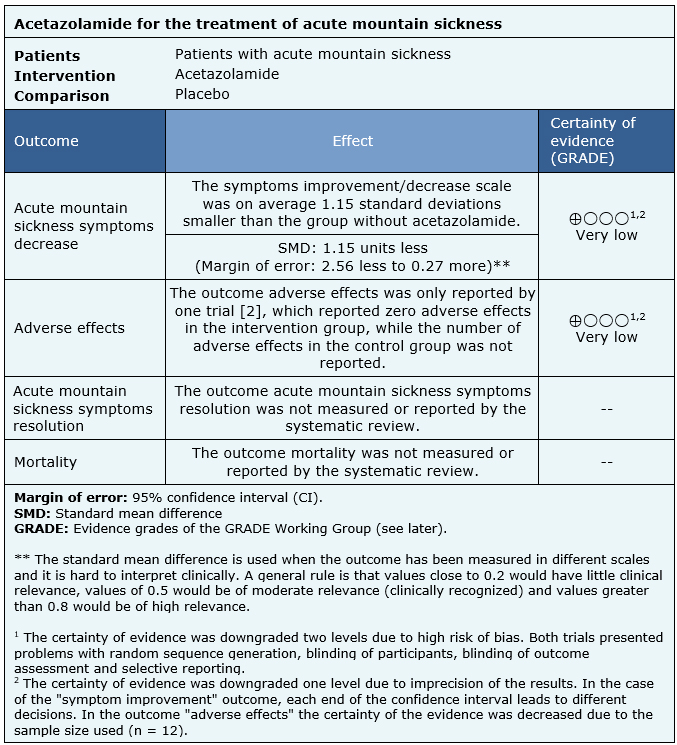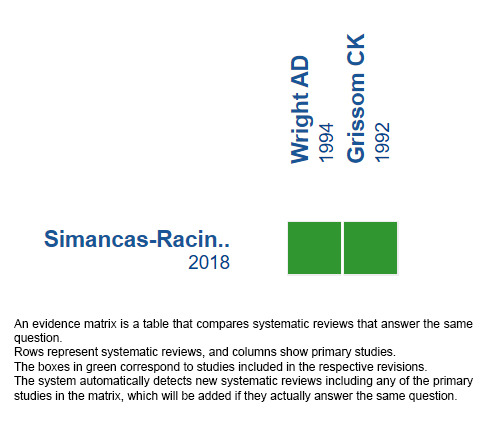 Para Descargar PDF debe Abrir sesión.
Para Descargar PDF debe Abrir sesión.
Palabras clave: altitude, acute mountain sickness, acetazolamide, Epistemonikos, GRADE.
INTRODUCTION
Acute mountain sickness is the most prevalent illness related to acute exposure to high altitude, secondary to the hypobaric hypoxia effects in our body. Acetazolamide has been traditionally used for its prevention and treatment, however, there is still controversy regarding the degree of usefulness of this medication as monotherapy.
METHODS
We searched in Epistemonikos, the largest database of systematic reviews in health, which is maintained by screening multiple information sources, including MEDLINE, EMBASE, Cochrane, among others. We extracted data from the systematic reviews, reanalyzed data of primary studies, conducted a meta-analysis and generated a summary of findings table using the GRADE approach.
RESULTS AND CONCLUSIONS
We identified a systematic review that included two primary studies, both corresponding to randomized trials. We conclude that it is not possible to establish clearly whether treatment with acetazolamide reduces the symptoms of acute mountain disease or increases the risk of adverse effects, because the certainty of the existing evidence has been evaluated as very low.
When the organism is exposed to acute high-altitude hypobaric hypoxia, it develops a series of adaptive responses. However, if these responses are insufficient or abnormal, a spectrum of high-altitude illnesses that mainly include acute mountain sickness, high-altitude pulmonary edema and high-altitude cerebral edema, can occur. Of the three conditions previously indicated, acute mountain sickness is the most frequent, with its main symptoms being headache, fatigue, dizziness, nausea, vomiting, sleep disturbances and anorexia [1].
For the prevention and treatment of this syndrome, a series of non-pharmacological and pharmacological measures have been used. One of them is acetazolamide, which inhibits the carbonic anhydrase enzyme at the renal level and causes urinary bicarbonate excretion and metabolic acidosis. Its effect triggers compensatory hyperventilation and respiratory alkalosis, which promote the physiological response to the hypoxic stimulus. Despite being traditionally used, there is still controversy about the usefulness of acetazolamide as a treatment for acute mountain sickness[1].
We searched in Epistemonikos, the largest database of systematic reviews in health, which is maintained by screening multiple information sources, including MEDLINE, EMBASE, Cochrane, among others, to identify systematic reviews and their included primary studies. We extracted data from the identified reviews and reanalyzed data from primary studies included in those reviews. With this information, we generated a structured summary denominated FRISBEE (Friendly Summary of Body of Evidence using Epistemonikos) using a pre-established format, which includes key messages, a summary of the body of evidence (presented as an evidence matrix in Epistemonikos), meta-analysis of the total of studies when it is possible, a summary of findings table following the GRADE approach and a table of other considerations for decision-making.
|
Key messages
|
|
What is the evidence. |
We found one systematic review [1], which included two primary studies [2], [3], both corresponding to randomized trials. |
|
What types of patients were included* |
Both trials included patients with acute mountain sickness, that is, subjects acutely exposed to high-altitude, presenting symptoms of headache, fatigue, dizziness, nausea, vomiting, sleep disturbances and anorexia. |
|
What types of interventions were included* |
Both trials evaluated the use of acetazolamide orally. One trial [2] administered 250 mg at 0 and 8 hours and the other [3] 20 mg/kg at baseline and then 500 mg daily for 5 days. |
|
What types of outcomes |
The trials reported multiple outcomes, which were grouped by systematic review as follows:
Primary outcomes:
Secondary outcomes:
|
* The information about primary studies is extracted from the systematic reviews identified, unless otherwise specified.
The information on the effects of acetazolamide for the treatment for acute mountain sickness is based on two randomized trials that included 25 patients.
Two trials reported acute mountain sickness symptoms decrease (25 patients) [2], [3], only one trial reported adverse effects, with incomplete results (12 patients) [2]. No trial reported the outcomes mortality or acute mountain sickness symptoms resolution.
The summary of findings is as follows:

| Follow the link to access the interactive version of this table (Interactive Summary of Findings – iSoF) |

|
To whom this evidence does and does not apply |
|
| About the outcomes included in this summary |
|
| Balance between benefits and risks, and certainty of the evidence |
|
| Resource considerations |
|
| What would patients and their doctors think about this intervention |
|
|
Differences between this summary and other sources |
|
| Could this evidence change in the future? |
|
Using automated and collaborative means, we compiled all the relevant evidence for the question of interest and we present it as a matrix of evidence.

Follow the link to access the interactive version: Acetazolamide for the treatment of acute mountain syndrome.
The upper portion of the matrix of evidence will display a warning of “new evidence” if new systematic reviews are published after the publication of this summary. Even though the project considers the periodical update of these summaries, users are invited to comment in Medwave or to contact the authors through email if they find new evidence and the summary should be updated earlier.
After creating an account in Epistemonikos, users will be able to save the matrixes and to receive automated notifications any time new evidence potentially relevant for the question appears.
This article is part of the Epistemonikos Evidence Synthesis project. It is elaborated with a pre-established methodology, following rigorous methodological standards and internal peer review process. Each of these articles corresponds to a summary, denominated FRISBEE (Friendly Summary of Body of Evidence using Epistemonikos), whose main objective is to synthesize the body of evidence for a specific question, with a friendly format to clinical professionals. Its main resources are based on the evidence matrix of Epistemonikos and analysis of results using GRADE methodology. Further details of the methods for developing this FRISBEE are described here (http://dx.doi.org/10.5867/medwave.2014.06.5997)
Epistemonikos foundation is a non-for-profit organization aiming to bring information closer to health decision-makers with technology. Its main development is Epistemonikos database (www.epistemonikos.org).
Potential conflicts of interest
The authors do not have relevant interests to declare.
 Esta obra de Medwave está bajo una licencia Creative Commons Atribución-NoComercial 3.0 Unported. Esta licencia permite el uso, distribución y reproducción del artículo en cualquier medio, siempre y cuando se otorgue el crédito correspondiente al autor del artículo y al medio en que se publica, en este caso, Medwave.
Esta obra de Medwave está bajo una licencia Creative Commons Atribución-NoComercial 3.0 Unported. Esta licencia permite el uso, distribución y reproducción del artículo en cualquier medio, siempre y cuando se otorgue el crédito correspondiente al autor del artículo y al medio en que se publica, en este caso, Medwave.

INTRODUCTION
Acute mountain sickness is the most prevalent illness related to acute exposure to high altitude, secondary to the hypobaric hypoxia effects in our body. Acetazolamide has been traditionally used for its prevention and treatment, however, there is still controversy regarding the degree of usefulness of this medication as monotherapy.
METHODS
We searched in Epistemonikos, the largest database of systematic reviews in health, which is maintained by screening multiple information sources, including MEDLINE, EMBASE, Cochrane, among others. We extracted data from the systematic reviews, reanalyzed data of primary studies, conducted a meta-analysis and generated a summary of findings table using the GRADE approach.
RESULTS AND CONCLUSIONS
We identified a systematic review that included two primary studies, both corresponding to randomized trials. We conclude that it is not possible to establish clearly whether treatment with acetazolamide reduces the symptoms of acute mountain disease or increases the risk of adverse effects, because the certainty of the existing evidence has been evaluated as very low.
 Autores:
Luciano Tapia[1,2], Sebastián Irarrázaval[2,3]
Autores:
Luciano Tapia[1,2], Sebastián Irarrázaval[2,3]

Citación: Tapia L, Irarrázaval S. Acetazolamide for the treatment of acute mountain sickness. Medwave 2019;19(11):e7736 doi: 10.5867/medwave.2019.11.7736
Fecha de envío: 3/7/2019
Fecha de aceptación: 1/10/2019
Fecha de publicación: 9/12/2019
Origen: Este artículo es producto del Epistemonikos Evidence Synthesis Project de la Fundación Epistemonikos, en colaboración con Medwave para su publicación.
Tipo de revisión: Con revisión por pares sin ciego por parte del equipo metodológico del Epistemonikos Evidence Synthesis Project.

Nos complace que usted tenga interés en comentar uno de nuestros artículos. Su comentario será publicado inmediatamente. No obstante, Medwave se reserva el derecho a eliminarlo posteriormente si la dirección editorial considera que su comentario es: ofensivo en algún sentido, irrelevante, trivial, contiene errores de lenguaje, contiene arengas políticas, obedece a fines comerciales, contiene datos de alguna persona en particular, o sugiere cambios en el manejo de pacientes que no hayan sido publicados previamente en alguna revista con revisión por pares.
Aún no hay comentarios en este artículo.
Para comentar debe iniciar sesión
 Medwave publica las vistas HTML y descargas PDF por artículo, junto con otras métricas de redes sociales.
Medwave publica las vistas HTML y descargas PDF por artículo, junto con otras métricas de redes sociales.
 Simancas‐Racines, Daniel, Arevalo‐Rodriguez, Ingrid, Osorio, Dimelza, Franco, Juan VA, Xu, Yihan, Hidalgo, Ricardo. Interventions for treating acute high altitude illness. Cochrane Database of Systematic Reviews. 2018;6:CD009567.
Simancas‐Racines, Daniel, Arevalo‐Rodriguez, Ingrid, Osorio, Dimelza, Franco, Juan VA, Xu, Yihan, Hidalgo, Ricardo. Interventions for treating acute high altitude illness. Cochrane Database of Systematic Reviews. 2018;6:CD009567.  Grissom CK, Roach RC, Sarnquist FH, Hackett PH. Acetazolamide in the treatment of acute mountain sickness: clinical efficacy and effect on gas exchange. Annals of internal medicine. 1992;116(6):461-5.
Grissom CK, Roach RC, Sarnquist FH, Hackett PH. Acetazolamide in the treatment of acute mountain sickness: clinical efficacy and effect on gas exchange. Annals of internal medicine. 1992;116(6):461-5.  Wright AD, Winterborn MH, Forster PJ, Delamere JP, Harrison GL, Bradwell AR. Carbonic anhydrase inhibition in the immediate therapy of acute mountain sickness. Journal of Wilderness Medicine. 1994;5(1):49-55.
Wright AD, Winterborn MH, Forster PJ, Delamere JP, Harrison GL, Bradwell AR. Carbonic anhydrase inhibition in the immediate therapy of acute mountain sickness. Journal of Wilderness Medicine. 1994;5(1):49-55.  Netzer N, Strohl K, Faulhaber M, Gatterer H, Burtscher M. Hypoxia-related altitude illnesses. J Travel Med. 2013 Jul-Aug;20(4):247-55.
Netzer N, Strohl K, Faulhaber M, Gatterer H, Burtscher M. Hypoxia-related altitude illnesses. J Travel Med. 2013 Jul-Aug;20(4):247-55.  Luks AM, McIntosh SE, Grissom CK, Auerbach PS, Rodway GW, Schoene RB, Zafren K, Hackett PH; Wilderness Medical Society. Wilderness Medical Society practice guidelines for the prevention and treatment of acute altitude illness: 2014 update. Wilderness Environ Med. 2014 Dec;25(4 Suppl):S4-14.
Luks AM, McIntosh SE, Grissom CK, Auerbach PS, Rodway GW, Schoene RB, Zafren K, Hackett PH; Wilderness Medical Society. Wilderness Medical Society practice guidelines for the prevention and treatment of acute altitude illness: 2014 update. Wilderness Environ Med. 2014 Dec;25(4 Suppl):S4-14.